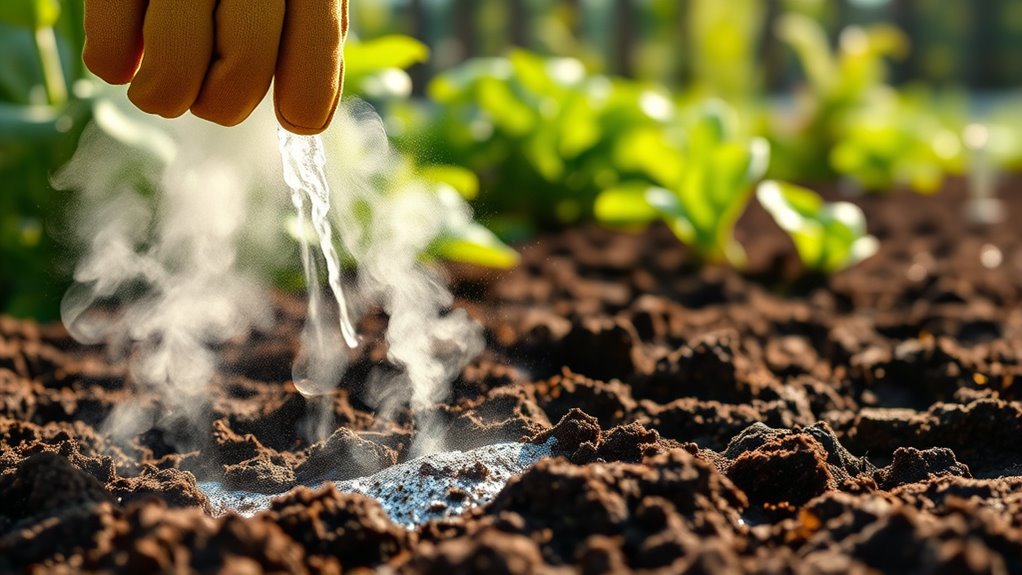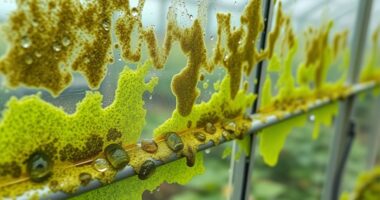Soil sterilization helps you eliminate soil-borne diseases, pests, and weed seeds, creating a healthy environment for your plants. You can use heat-based methods like solarization or steaming, especially for small patches, or industrial techniques for larger areas. While effective, sterilization also kills beneficial microbes, so you’ll need to reintroduce helpful organisms afterward. Understanding the best practices guarantees you tackle issues at their root—stick with us to explore how to do it right.
Key Takeaways
- Soil sterilization eliminates pathogens, pests, and weed seeds, preventing root diseases and promoting healthy plant growth.
- Heat-based methods like solarization or steaming effectively sterilize small to medium soil quantities.
- Post-sterilization, reintroduce beneficial microbes through compost or inoculants to restore soil health.
- Combining sterilization with soil amendments enhances nutrient availability and microbial diversity.
- Proper technique selection and timing prevent soil damage and ensure long-term disease management.

Soil sterilization is a critical process used to eliminate harmful pathogens, pests, and weed seeds from soil, ensuring a clean environment for planting. If you want to prevent plant diseases and promote healthy growth, understanding sterilization techniques becomes indispensable. When you sterilize your soil, you’re effectively breaking the cycle of disease-causing organisms that can lurk beneath the surface. This process is especially important if you’re starting a new garden bed or reusing soil that may have been contaminated. By reducing the microbial load, you minimize the risk of disease outbreaks that can devastate your plants.
There are several sterilization techniques you can employ, each suited to different scales and resources. Heat-based methods are among the most common and effective. For small-scale gardening, you might use methods like solarization—covering moist soil with clear plastic during hot, sunny days to harness the sun’s energy and raise the soil temperature to lethal levels for pathogens. This technique is straightforward, environmentally friendly, and requires minimal equipment. Alternatively, steaming or boiling soil in a large pot can sterilize small quantities effectively, killing pathogens, weed seeds, and pests. For larger areas, you might consider more industrial methods like soil fumigation using chemical agents or steam sterilization in specialized equipment. Additionally, selecting vetted products designed for soil sterilization can improve safety and effectiveness.
Sterilization techniques greatly contribute to disease prevention. By killing off the microorganisms responsible for soil-borne diseases, you create a safer environment for your plants to thrive. This reduces the need for chemical treatments later on and supports organic gardening practices. However, it’s essential to remember that sterilized soil lacks beneficial microorganisms as well, so you’ll need to reintroduce these after sterilization through composting or inoculants to maintain soil health. Reestablishing a diverse microbial community helps restore the natural balance and resilience of your soil. Proper timing and method selection are crucial to ensure you don’t damage your soil’s structure or biodiversity more than necessary.
Keep in mind that sterilization isn’t a one-size-fits-all solution. Over-sterilizing can lead to sterile soil that’s vulnerable to reinfection, so use these techniques judiciously. For example, if you’re dealing with persistent diseases like fusarium or phytophthora, sterilization can be a game-changer. But for routine maintenance, less aggressive methods might suffice. Always monitor your soil’s health afterward and consider supplementing with organic matter and beneficial microbes to restore its natural balance. Incorporating soil amendments after sterilization can help quickly reintroduce essential nutrients and microbes, promoting healthy plant growth.
Frequently Asked Questions
How Long Does Sterilized Soil Remain Free of Pathogens?
You’re wondering how long sterilized soil stays free of pathogens. The sterilization duration depends on the method used, but generally, sterilized soil can remain pathogen-free for several weeks to months. Soil pathogen persistence varies, so some microbes may reappear over time, especially if contaminated sources are introduced. To maintain a pathogen-free environment, re-sterilization or proper soil management is essential, ensuring long-term disease control and healthy plant growth.
Are There Eco-Friendly Soil Sterilization Alternatives?
Imagine a garden bursting with life, not chemicals. You can choose eco-friendly soil sterilization options like biodegradable methods and natural amendments, which gently restore soil health without harming the environment. These alternatives actively fight pathogens while nurturing beneficial microbes. Unlike traditional sterilization, they sustain soil vibrancy, making your garden both productive and sustainable. Embracing these options helps you protect the planet while cultivating healthy, disease-free plants.
Can Sterilization Harm Beneficial Soil Microorganisms?
You might worry that sterilization could harm beneficial microbes essential for soil health. While it’s true that sterilization kills harmful pathogens, it can also eliminate beneficial microbes that support plant growth. To protect soil health, consider targeted or eco-friendly methods that reduce disease without destroying these crucial microorganisms. This way, you maintain a balanced soil ecosystem, promoting healthier plants and sustainable gardening practices.
What Are the Cost Differences Between Sterilization Methods?
When comparing sterilization methods, you’ll find that chemical options like methyl bromide are often more expensive upfront, affecting economic feasibility. On the other hand, heat-based methods such as solar or steam sterilization can be more cost-effective, especially as a long-term investment. While initial costs vary, consider the longevity and effectiveness of each method to determine which best fits your budget and sustainable practices.
How Often Should Soil Be Sterilized in Crop Rotation?
You should sterilize soil during crop rotation based on soil health and sterilization timing. Typically, sterilization isn’t necessary every season; instead, do it when you notice disease buildup or declining soil quality. Regular monitoring helps determine the right frequency, often every 2-3 years, to prevent disease without harming beneficial microbes. Adjust your sterilization schedule according to crop needs and soil conditions for ideal results.
Conclusion
Soil sterilization removes harmful pathogens, restores soil health, and boosts plant growth. It prevents disease spread, protects your crops, and guarantees a healthier harvest. It’s a proactive step, a necessary measure, and an essential practice. By sterilizing soil, you take control, you safeguard your future, and you nurture the roots of success. Embrace soil sterilization today—protect the soil, secure the crop, and sustain the harvest for tomorrow.









